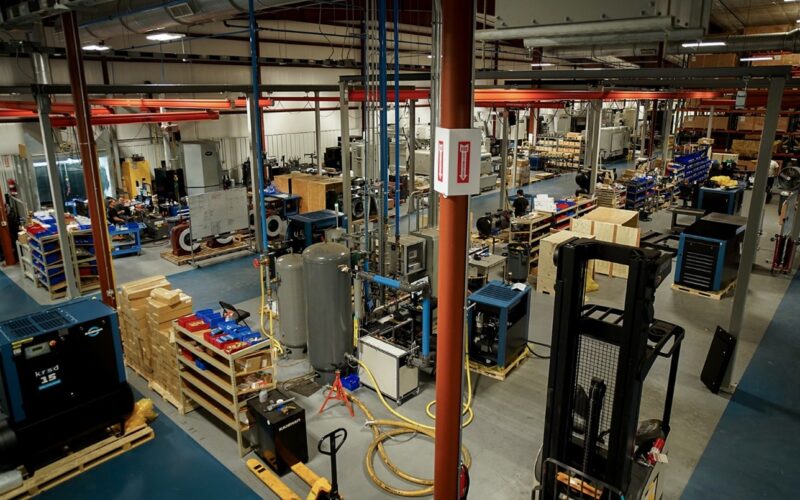Let’s say the sales VP walks into Monday morning’s operations meeting with a grin on his face and a big idea. He’s fired up. “We’re going to do a blitz,” he says. “Two weeks. Everybody on the phones. Emails. Door-knocking. We hit the entire territory and drive pipeline fast.”
Heads nod. The room buzzes. Reps clear their calendars. Sales starts building call lists. Leadership slaps together a goal sheet and commits to an aggressive outreach plan.
The energy is good.
But a month later, you’re looking at the CRM dashboard and something doesn’t add up.
A ton of calls. A few meetings. A trickle of deals. No real momentum.
What happened?
The hard truth about sales blitzes
Sales blitzes in B2B industrial manufacturing almost always start strong and fizzle out fast. Not because the team didn’t work hard. Not because the product isn’t solid. And not because the market doesn’t need what you’re selling.
They fail because marketing never got the call.
Here’s what most manufacturers don’t realize: industrial buyers don’t respond to urgency unless it feels personal, relevant, and timely. And that takes orchestration—something sales alone can’t do at scale.
What marketing brings to a blitz (that sales can’t)
Let’s back up. A sales blitz, by definition, is a concentrated burst of outbound activity aimed at generating leads, meetings, or closed deals within a defined time window. Think: 10 days of outbound calling, in-person visits, email follow-ups, and maybe a trade show appearance or regional demonstration sprinkled in.
But here’s the catch: all that outbound noise lands differently when the buyer has no context. No brand recognition. No warming. No signal that you’re solving their problem.
This step is where marketing earns its keep.
- Pre-awareness matters. A lot.
Sales teams are trained to close deals, not build mindshare. If your brand isn’t known, trusted, or at least understood before the first touch, you’re asking your reps to kick down doors that are locked from the inside. Industrial decision-makers are busy. They don’t want cold calls. They want clarity. Marketing helps you earn that trust before the blitz even begins. - Messaging must be calibrated to buyer pain—not product features.
Most blitzes fail because the messaging is vague, technical, or too focused on your internal language. “We make high-performance rotary lobe blowers” isn’t a hook—it’s a brochure sentence. What the buyer hears is: “Another vendor trying to sell me gear I don’t need.” - Segmentation is not optional.
Too often, blitz lists are built from outdated databases, CRM exports, or territory dumps. “Just hit everybody,” someone says. But “everybody” is not a strategy. It’s a signal that you haven’t done the work. - Campaigns > chaos.
A blitz without a campaign strategy is just random activity under a deadline. Marketing provides structure—pre-launch content, email drips, nurture flows, retargeting ads, landing pages, collateral. All designed to reinforce your message, earn credibility, and provide air cover for sales.
Marketing translates product speak into buyer impact. That means telling a story that connects with real-world problems—downtime, waste, poor output, missed specs, late deliveries. When the message lands, the call gets returned.
Good marketing ensures the right personas are being targeted—plant managers, maintenance managers, specifying engineers —with language and offers tailored to their world. No two buyers have the same pressure. No two plants run the same way. If you don’t segment, you’re just adding noise to their inbox.
You want a prospect to say, “Hey, I just saw something about you guys last week,” not, “Who are you again?”

The cognitive friction industrial buyers feel is real.
B2B industrial buyers—especially in manufacturing—don’t make fast decisions. Their work is complex. Their purchases are risky. If they buy the wrong screw compressor, it doesn’t just hurt their budget—it can cripple output, create downtime, or spark compliance issues.
And when they hear from your sales rep out of the blue, a few things flash through their head:
- “Who are these people?”
- “Why are they calling me?”
- “Do I trust them?”
- “Is this even a priority right now?”
- “How hard is it going to be to change?”
That’s a lot of cognitive friction. And it’s not the sales rep’s fault. The buyer doesn’t have enough information. They don’t see you as a category leader. They haven’t heard the customer story. They haven’t read the teardown of how you saved a food plant $82K last quarter.
Marketing eliminates that friction with content, timing, and proof.
The numbers speak for themselves
According to a McKinsey B2B decision-making study (https://www.demandgenreport.com/industry-news/80-of-b2b-buyers-initiate-first-contact-once-theyre-70-through-their-buying-journey/48394/), 70% of the buyer journey is completed before a customer talks to a rep. That means if marketing isn’t shaping the conversation before sales arrives, you’ve already lost ground.
Or think of it this way: if your average deal takes six touches before a serious conversation happens, why wouldn’t you pre-load three or four of those touches with valuable, relevant marketing before a blitz starts?
It’s basic math. It’s also common sense.

A coordinate playbook for the win
When marketing and sales work together, sales blitzes look a lot different and yield immediate results.
Let’s break it down: a four-phase approach ensures that every initiative is aligned, intentional, and impactful. Here’s how a successful blitz comes together along with the timing required for success.
Part 1: Intake and Alignment (1 week)
Success starts with alignment. It’s important to kick things off with an intake form and session between marketing and the blitz team. This ensures proper understanding of regional nuances and national goals from the start.
A collaborative, 60-minute kickoff meeting brings everyone to the table. In this session the blitz and marketing teams should align on shared goals, roles, and expectations and set communication norms and milestones, along with finalizing the timeline and Gantt chart.
Part 2: Pre-Blitz (4-6 weeks)
With alignment complete, it’s time for the collaborative sales and marketing teams to roll up their sleeves and get to work. This phase is all about strategic marketing preparation and refining the plan.
The best industrial marketers will start with deep target research and a review of the existing sales tools and collateral.
From there, marketing should build and launch the warm-up campaign—designed to drive appointments and interest through email and phone outreach. Afterward, conduct a review session to analyze performance and lock in the final blitz plan.
We close this phase by delivering a fully developed playbook and schedule for the live blitz.
Part 3: Live Blitz (1.5 weeks)
It’s game time. The live blitz kicks off with a full team pre-game call covering:
- Execution schedule and key tasks
- Messaging and scripts
- Brand etiquette and attire guidelines
- Sales tools and tracking systems
Part 4: Post-Blitz (1 week)
After the dust settles, we dig into the results. A 60-minute post-mortem call gives everyone a chance to reflect, share feedback, and talk performance.
Then we close the loop with:
- Organized lead data and handoff
- Final “thank you” emails to all engaged prospects
- A comprehensive performance report that outlines wins, learnings, and recommendations
It’s not about working harder. It’s about working together.
The myth of “sales is sales, marketing is marketing”
One of the biggest cultural barriers in industrial B2B manufacturing is the outdated belief that sales and marketing operate in separate lanes. That marketing is just “the arts and crafts department” and sales is where the real revenue happens.
That belief is killing your pipeline.
Great marketing is not fluffy. It’s foundational. It builds brand memory, drives preference, and removes resistance. When sales and marketing unify around the same target, same language, and same outcomes, the blitz becomes a flywheel—not a flash in the pan.
Agency partners are your secret weapon
Let’s be real. This all sounds amazing. But the reality is that most industrial manufacturers don’t have the internal bandwidth or experience to pull off the 4-part recipe for a blitz that we described above. Industrial marketing teams are lean. Sales teams are focused on quota. Leadership is stretched across operations, hiring, compliance, and product development.
So the blitz happens. But it never hits the ROI you forecast.
That’s where the right industrial B2B agency partner becomes a force multiplier. Not a vendor. A strategic operator who understands the sales process, the industrial buyer’s psychology, and how to build industrial B2B marketing campaigns that win. No BS. No fluff. Tailored industrial marketing for your brand. The recipe may be the foundation, but it always needs to be tweaked for your unique brand. Agencies that get industrial B2B are unicorns.
Final thoughts
Sales blitzes fail when they’re treated like sprints in a vacuum. Industrial buyers need more context, more credibility, and more value before they engage. That’s a good B2B marketer’s job. When marketing and sales work together—from the beginning—a blitz becomes a serious revenue driver, not just an activity report.
If your team doesn’t have the internal support to build and run coordinated campaigns, an industrial B2B marketing agency that has been in the trenches can help. The right partner will do more than make your brand look good. They’ll make it work.
RIVET has decades of experience helping brands nail their sales blitzes. Drop us a line if we can help. https://www.rivetagency.com/contact/





